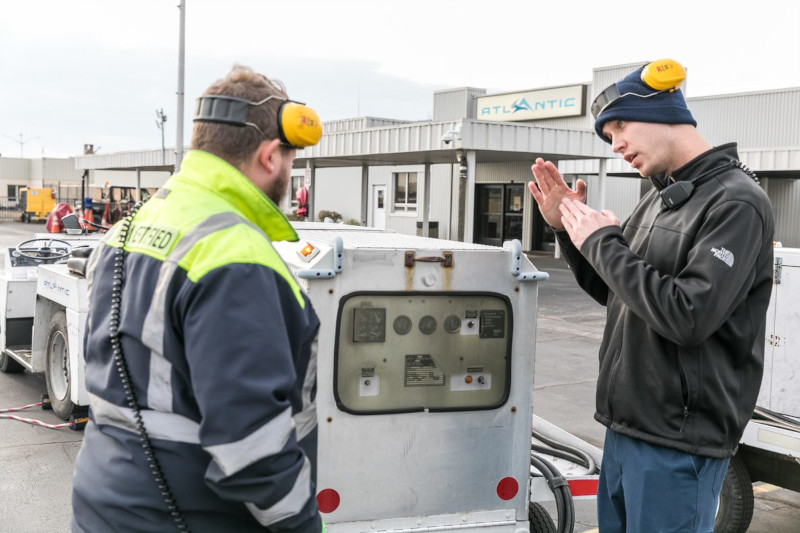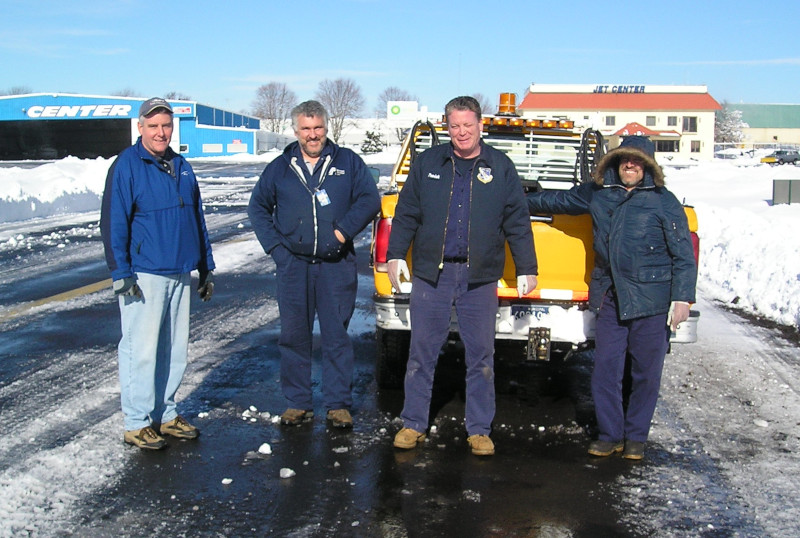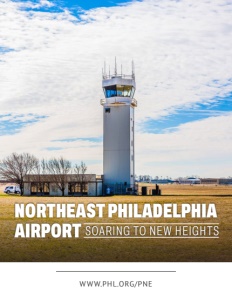Northeast Philadelphia Airport
Soaring to New Heights
Gearing towards significant upgrades and expanding operations to become a critical aviation hub in Pennsylvania.
Northeast Philadelphia Airport (PNE) is a significant hub in Pennsylvania’s aviation industry, covering an expansive 1,150 acres. Positioned conveniently about 13 miles from downtown Philadelphia, it offers a less congested alternative to Philadelphia International Airport, making it a preferred choice for corporate and private travelers. With its robust infrastructure, PNE boasts two long runways capable of handling a wide range of aircraft sizes. The airport is home to approximately 215 aircraft, including single-engine planes, twins, jets, turboprops, and helicopters.
Northeast Philadelphia Airport’s activity has been impressive, says John Brewer, the Airport Manager. “We ended 2023 with 114,775 operations, which made us the third busiest airport in the Commonwealth of Pennsylvania,” he notes. With Philadelphia International being first and Pittsburgh second, this positions Northeast Philadelphia Airport as the busiest general aviation airport in the state.
Brewer attributes much of this activity to the robust flight training programs. “We have four flight schools at the airport. Legacy Aviation is the busiest, with over 200 students at any one time. Tailwinds Flight Education and ATP, one of the nation’s largest flight schools, have also been growing steadily. We’re happy about that, as it contributes to addressing the pilot shortage,” he explains.
In addition to pilot training, the Aviation Institute of Maintenance also plays a significant role. “Many of their graduates either go on to work with airlines or stay right here at the airport, working with companies like Leonardo, the helicopter production company.”
Safety remains a paramount concern, especially with Leonardo’s activities. “Leonardo has its own crash fire rescue since its helicopters need to be turned on and lifted off for the first time here,” Brewer says. The Philadelphia Fire Department supports this effort, with multiple fire companies ready to respond. A series of tabletop and full-scale exercises are planned to ensure preparedness.
Northeast Philadelphia Airport is not only about flying; it’s also evolving in terms of infrastructure. An old restaurant, Flatspin, which closed about eight years ago, has been demolished. “As we were tearing the building down, a gentleman who hangared his planes with the FBO approached us. We are now finalizing a lease for him to develop another corporate hangar, complete with an apron and taxiway,” Brewer shares.
Although the airport currently lacks a dedicated restaurant, its location within Philadelphia offers plenty of dining options nearby. “There are restaurants within a mile you can walk to, and courtesy cars or rental cars are available for those who prefer to drive. There’s a wide variety of eating establishments and convenience stores close by,” Brewer mentions.
There’s potential for a dining facility to return to the airport. “Recently, someone expressed interest in opening a diner serving breakfast and lunch. It’s in the early stages, but it would be neat. It would benefit all the users here during the day so they wouldn’t necessarily have to leave the airport,” Brewer adds, hinting at exciting developments on the horizon.

Infrastructure and Upgrades
Northeast Philadelphia Airport is continuously evolving to enhance safety and efficiency. This commitment to improvement is evident in several major projects undertaken recently.
“In 2023, we started the rehabilitation of our taxiway, Lima,” Brewer notes. This extensive project involves a 5,000-foot-long taxiway parallel to runway 624. “We’re rehabilitating it over three years. Package one was completed in 2023, and package two has just started and is expected to take about two months. Next year, we’ll tackle package three,” he explains.
Additionally, a creek and culvert project has been successfully completed. “We relocated a creek that goes through the airport and installed a concrete culvert with a flap gate,” Brewer shares. This innovation improves water flow and enhances security by preventing deer from entering the airport grounds. “The gate is effective because it’s too heavy for the deer to lift, ensuring they can’t get onto the airport,” he adds.
Another significant development is the forthcoming air traffic control tower. “We’re getting closer to finalizing a deal with the FAA for a new tower,” Brewer says. The new tower will be about 50 feet taller than the current one and fully modernized. “We’re hoping to break ground on that later this year,” he mentions, noting that controllers will benefit from improved airport visibility.
Security upgrades are also on the agenda. “Later this year, we’re starting a security fence replacement project, which will replace about 80% of the airport’s security fence and gates,” Brewer says. This year-long project aims to bolster the airport’s overall safety. Additionally, almost 1,900 feet of sidewalk around the airport has been replaced to meet the Philadelphia code, including installing ten new handicap ramps.
Brewer also highlights efforts to address more minor yet crucial safety concerns. “We have some old trench drains on the airfield, remnants of a de-icer collection system from when the airport had airline service in the 60s, 70s, and 80s,” he explains. These outdated drains are now creating debris issues, so they will be removed and filled with concrete. “We’re focused on getting these little safety improvement projects done,” he adds.
The airport is finalizing a lease with a new FBO, SARS Trilogy, which plans to operate as Aero Center Northeast Philadelphia. “We’re close to finalizing that. We’re waiting on the FAA to see if we need a full-blown environmental assessment or an expedited one,” Brewer says. The goal is to have the FBO up and running before 2026, a landmark year for Philadelphia. “2026 will be a tremendous year for Philadelphia, with World Cup soccer games, the Major League Baseball All-Star game, and the 250th anniversary of our country,” Brewer points out. In preparation, the airport will also rehabilitate its crosswind runway and start another taxiway project next year. “We’ve been very fortunate to get a lot of grant money from the FAA, and we have more grant money on the way,” Brewer adds.
Rising Numbers and Growing Efficiency
Northeast Philadelphia Airport has seen a significant surge in activity over recent years, reflecting its growing importance and efficiency. This upward trend in operations showcases the airport’s expanding role in serving diverse aviation needs.
Brewer details the remarkable growth in operations: “We ended 2023 with 114,775 operations, up almost 20,000 from 2022, which had 95,991. 2021 we had 83,751, so that’s a 12,000 increase from 2021 to 2022.” Even with a slower February due to bad weather, the overall trend remains positive. “They’re more than making up for it right now,” he notes.
Law enforcement and medical flights are vital to the airport’s operations. “There’s a lot of medical flights in and out due to the major hospitals in Philadelphia,” Brewer says. “The Philadelphia police are based here, and a couple of federal agencies operate out of this airport.”
Brewer emphasizes the need for improved airfield efficiency with the increase in flight school activities. “We’re trying to develop a run-up apron where flight schools can perform run-ups without calling the tower,” he explains. This would streamline operations by allowing planes to call the tower only when ready to taxi to the runway. “The airfield is getting inundated with single-engine planes. It’s not uncommon to see four or five, sometimes six planes waiting to depart, creating delays when mixed with corporate jets.”
The airport is actively seeking solutions to enhance traffic flow. “We’ve identified key areas where we could put in taxiways to get traffic on and off runways faster,” Brewer says. This focus on efficiency is driven by the rapid growth in activity. “The growth shot up a lot faster than we anticipated, but it’s a good problem to have.”
Economic impact is another area where the airport excels. “In 2022, this airport had a $974 million economic impact on the region,” Brewer highlights. “Almost $1 billion from a general aviation airport is pretty good.” The airport also boasts a substantial employment base. “We have just over 4,000 employees working at the airport, including all tenants and their aviation and non-aviation employees. Leonardo, the helicopter production company, is the largest employer with just over a thousand employees.”

Expanding Operations and Enhancing Services
As Northeast Philadelphia Airport gears up for a monumental year in 2026, plans are underway to address growing demands and enhance operational efficiency. The airport is committed to expanding its services to accommodate increased activity and ensure a safe and efficient environment for all users.
“It’s gotten so busy that we decided to expand our operations department from a 16-hour operation to 24 hours, seven days a week,” Brewer reveals. “We’re conducting interviews now and will hire and train new staff. In about four months, we should have our operations staff here round the clock.” This change addresses the need for continuous monitoring and support, especially given the significant nighttime activity at the airport. “Having the operations department here 24 hours will fill a critical vacancy,” he adds.
Philadelphia’s rich historical significance and vibrant dining scene attract millions of visitors annually. Brewer sees the airport playing a vital role in this influx. “Continuing to operate a safe and efficient airport, especially during winter, is crucial,” he says. The convenience of charter flights has also contributed to the airport’s growth. “Covid made many people realize they can fly charter for just a bit more than commercial, especially if a few families pool their money together.”
Looking ahead, Brewer outlines the critical projects slated for the coming year. “Ongoing construction is a priority. We hope to finish package two of taxiway Lima, replace 80% of the airport’s security fence, install new sidewalks and handicap ramps, and fill in some old drains,” he details. The expansion of the operations department to 24/7 is a significant milestone. “We’re also aiming to have another corporate hangar, a new FBO, and a new tower underway.”
A dedicated full-time construction manager and the executive staff at Philadelphia International Airport (PHL) support the airport’s construction and development efforts. “This airport is owned and operated by the city, just like PHL,” Brewer notes. The executive staff at PHL recognizes the importance of this airport and is committed to seeing it flourish and grow.”
With substantial projects on the horizon and a clear focus on efficiency and safety, Northeast Philadelphia Airport is poised to continue its growth and service enhancement trajectory, ensuring it remains a pivotal hub in the region.
AT A GLANCE
Northeast Philadelphia Airport
What: A significant general aviation airport serving corporate, private, law enforcement, and medical flights
Where: Philadelphia, Pennsylvania
Website: https://www.phl.org/PNE



